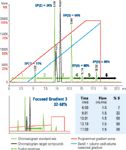Using Focused Gradients on a Combined Analytical/Preparative HPLC System to Optimize the Purification Scale-up Process
Agilent Technologies Inc.
This application note describes how a focused gradient is used to optimize the scale-up process from a 4.6 × 250 mm analytical column to a 50 × 243 mm preparative HPLC purification column.
Direct scale-up from analytical flow rates of 1.5 mL/min to preparative flow rates of 177 mL/min on a combined system poses several challenges: solvent delivery must be accurate at both low and high flow rates, and detection must span a wide dynamic range to cope with vastly different concentrations (1–5).
Experimental Conditions (6)
Agilent SD-1 Binary Purification System with Agilent Prep-C18 Scalar, 4.6 × 250 mm, 10 µm analytical column and Agilent Load & Lock preparative column, 50 × 243 mm, packed with 300 g of Agilent Prep-C18, 10 µm, at 1500 psi.
Formulas from the literature were used to scale-up the generic gradient profile from the analytical to preparative column (3,4). Taking dwell volume and column dead volume into consideration, the elution points of five standard compounds were determined using a linear elution gradient from 2 to 98% B within 16 min. The elution points of two adjacent peaks gave the start- and end-points of the focused gradients each with a slope of 2% B/min.

Figure 1: Generic and focused gradient applied to the standard calibration mixture and overlaid with a sample.
Results
5 µL of sample were analyzed on the analytical column using the generic gradient profile. The two target compounds eluted within window #3, hence focused gradient #3 was used for purification. A resolution of 1.11 for the two compounds was still obtained with an injection volume of 40 µL equivalent to 18.7 mg of sample. For purification on the preparative column, the scale-up formula was used to calculate a final injection volume of 4500 µL (2.11 mg). The recovery level of the collected fractions was 85 and 89%, respectively.
Conclusion
The Agilent SD-1 Purification System is a combined analytical/preparative HPLC system that provides for straightforward scale-up from a 4.6 × 250 mm i.d. analytical column to a 50 × 243 mm i.d. self-packed Agilent Load & Lock column. A focused gradient facilitated increase of column load and reduced runtime and solvent consumption.
References
(1) J.W. Dolan, LCGCNorth Am. 24(5), 458–466 (2006).
(2) J.W. Dolan and L.R. Snyder, J. of Chromatography A 99, 21–34 (1998).
(3) D. Guillarme, D. Nguyen, S. Rudaz, and J.L. Veuthey, Eur.J. Pharm. Biopharm. 66, 475–482 (2007).
(4) D. Guillarme, D. Nguyen, S. Rudaz, and J.L. Veuthey, Eur.J. Pharm. Biopharm. 68, 430–440 (2008).
(5) L.R. Snyder, J.J. Kirkland, and J.W. Dolan, Introduction to Modern Liquid Chromatography (3rd Edition, Wiley, Hoboken, New Jersey, 2010), pp. 403–498.
(6) P. Penduff, Scale-up with the Agilent SD-1 Purification System Analytical and Preparative Runs on a Single System, Agilent publication number 5991-2012EN, 2013.
Agilent Technologies Inc.
5301 Stevens Creek Blvd., Santa Clara, CA 95051
tel. (800) 227-9770 (Directory)
Website: www.agilent.com/chem/purifyyourway

The Benefits of Custom Bonded Silica
April 1st 2025Not all chromatography resins are created equal. Off-the-shelf chromatography resins might not always meet the rigorous purification requirements of biopharmaceutical manufacturing. Custom bonded silica from Grace can address a wide range of separation challenges, leading to real performance improvements. Discover more about the latest innovations in chromatography silica from Grace, including VYDAC® and DAVISIL®.
5 Things to Consider When Selecting a Chromatography Silica
April 1st 2025Particularly in the pharmaceutical industry, drug purity isn’t just a goal – it’s essential for achieving safety, stability and efficacy. However, purification is easier said than done, especially with challenging molecules like DNA and RNA “oligonucleotides,” due in large part to their diversity and the range of impurities that can be generated during production. Enter DAVISIL® chromatographic silica, with a wide range of pore diameters and particle sizes to meet your specific application, performance and sustainability requirements. Before you choose the chromatography resin for your next purification application, take a look at these 5 considerations.
Automating Protein Purification: Efficiency, Yield, and Reproducibility
March 27th 2025Recent advancements in automated protein purification stress the importance of efficiency, scalability, and yield consistency. This eBook compares different purification platforms, highlighting their impact on downstream applications and demonstrating how automation enhances throughput and process control.
MilliporeSigma: Ultrapure Water for Sensitive LC-MS Analysis of Pesticides
March 25th 2025The aim of the study was to illustrate the efficiency of Milli-Q® water purification systems in eliminating pesticides from tap water, thereby producing and delivering reliable and consistent-quality ultrapure water suitable for pesticides analysis















